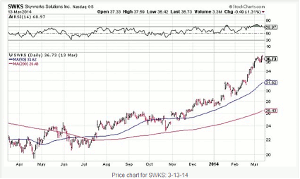Alan Ellman of TheBlueCollarInvestor.com goes through the details of a twist on the plain-vanilla covered call strategy to see what risks and benefits might be involved.
Covered call writing is a strategy that can be applied in several different manners. I have written about generating monthly cash flow, the main reason we use this great strategy. But it can also be used to augment long-term buy-and-hold portfolios, enhance dividend distributions by decreasing our cost basis and protect us in bear market environments with some downside protection. The common thread is more cash in our pockets in all these scenarios.
Recently, one of our members, Rick from upstate NY, wrote me suggesting a twist to our covered call writing strategy where both in-the-money and out-of-the-money options are sold after buying 100 shares of stock. My reaction was probably the same as yours…we are now “covered” in only half of our short positions. So my initial concerns are:
- We are undertaking added risk
- Will our brokerage approve us for naked call options trading (selling options without owning the stock first)
- Is this an appropriate strategy for the level of risk tolerance we are willing to undertake
For most of us it is not an appropriate strategy nor will our brokerage likely approve us for this level of trading. More sophisticated traders with higher cash accounts will get the broker approval.
Despite this, I do feel that it would be a valuable exercise to set up some hypothetical trades that will give us some ideas as to the risks and benefits of such a combination strategy.
The stock I selected from our premium Watch List is Skyworks Solutions, Inc. (SWKS). Have a look at the beautiful price chart as of the penning of this article:

charts by www.Livevolpro.com
Click to Enlarge
Here are the hypothetical parameters I’ll use in this week’s article (initial stats taken from a real options chain for SWKS on March 13, 2014, and a five-week return):
Initial stats
- Buy 100 x SWKS @ $37
- Sell $35 call @ $2.65 (1.9% return; 5.4% downside protection of the profit)
- Sell $38 call @ $1 (2.7% return; 2.7% upside potential)
Hypothetical closing prices to be evaluated
- $30
- $36.50
- $44
We will evaluate the returns if share price rises or falls by $7 and closes between the two strikes.
If stock price drops to $30 by expiration
- Neither option is exercised
- Unrealized share loss = $7
- Total premiums collected = $3.65
- Net unrealized loss = (-)2.35 = (-)6.4%
- The risk and unrealized loss is magnified as share price declines below $30, if no exit strategies are instituted
If stock price rises to $44
- Both options will be exercised
- We will need to buy 100 shares @ $44 to cover the naked option
- Average cost per share = $40.50 ($44 + $37/2)
- Average sale price = $36.50 ($38 + $35/2)
- Share loss = $4
- Total premiums collected = $3.65
- Net loss = $0.35 = 0.9% ($0.35/$40.50)
- The risk and loss is magnified if share price moves above $44 and no exit strategies are initiated
If stock price closes @ $36.50
- The $35 call will be exercised and generate $35 per share
- The $38 call will not be exercised
- Share loss is $2 per share (buy @ $37 and sell @ $35)
- Total premiums collected = $3.65
- Net profit = $1.65 = 4.5%
Takeaways from these hypothetical trades
- A closing price between the 2 strikes will result in a handsome return
- Extreme share acceleration or depreciation will result in a loss, perhaps a catastrophic loss because half our position was uncovered initially
Conclusion
Adding an uncovered or naked component to covered call writing changes everything. We are incurring more risk for a strategy that is geared to conservative investors with capital preservation as a key requirement. There are many ways to make money in the stock and options markets and each investor must evaluate his (her) own risk tolerance before deciding which of those strategies are appropriate for the family portfolio.
By Alan Ellman of TheBlueCollarInvestor.com





















